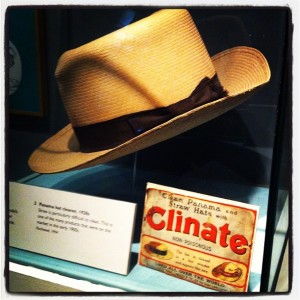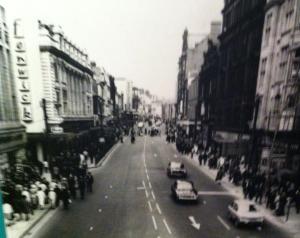Hundreds of people, everyday walk down Northumberland Street in Newcastle. It is a high street that has become home to the most successful shopping outside of Oxford Street in London. It now houses a huge range of stores and brand names which are recognisable all over the world, Primark, H and M and Marks and Spencer are just a few that receive visitors from every age and class everyday. In Britain we spend an average of 6% of our yearly income on clothes, this adds up to £15 billion, but shopping hasn’t always been such a way of life.
By the 1800’s most villages had a dress maker or tailor, but each business was specific to its own skills, there were separate shops for each item, corset makers, shoe makers, glovers and drapers. Clothing was made to measure from the latest styles in newspapers. It wasn’t until the development of shopping arcades that different trades were brought together under one roof.
Bainbridge, situated on Market Street in Newcastle, an already successful draper, began to stock ready made clothes as well as the raw materials. This became a new type of shop, the first department store in the world.
When faced with the topic of department stores and Newcastle it’s difficult not to think of Fenwick. J.J Fenwick opened his dress shop in 1882 on Northumberland Street, and Fenwick continued to dominate in to the 1960’s. The shop then moved to numbers 37 and 39 Northumberland Street, making more room for the elegant window displays which are still famous today. Fenwick is the ideal shop to describe Newcastle, with it’s strong local roots, however it is not afraid to branch out and travel elsewhere to do business.
Shopping was once a pastime that was preserved for middle and upper social classes, only the wealthy could afford good quality and high fashion. The development of the high street has made fashion accessible to everyone, with the expansion of shops such as Primark – striving to sell fashionable clothes at low prices – copying looks from the catwalk is now easy and inexpensive. It is possible that this is why trends now change more rapidly than they ever have before.
Since the beginning of the 2000’s, the catwalk has begun to merge with the high street, with high profile designers creating collections for high street shops, for example Stella McCartney for H and M and Kate Moss for Topshop.
Another recent development is that of supermarkets bringing out their own fashion brands, such as Asda with George. This is the ultimate example of fashion at very affordable prices. It is common that as individuals we now shop at a selection of all of these outlets, mixing higher quality pieces with cheaper items, a stark contrast to when all items would come from one department store.
Online shopping is another outlet that has expanded massively in recent years. Kays was the first firm in America in the 1800’s to sell products by mail only. By the late 1970’s Littlewoods had captured 5% of the UK’s women’s clothing market. Today over half of British adults shop online each year. The development of websites such as Kingshill and Net-a-Porter means that designer clothes are now available on the internet.
More recent additions to the online market are websites such as www.pretaportabello.com which enables the shopper to shift through bargain bins, vintage collections and even haggle for items, as though they were actually at a market. ASOS Marketplace is a similar site where individuals can buy and sell vintage and homemade items.
The way we shop is constantly evolving and developing along with the clothes we wear and the trends we follow. Tomorrow hundreds more people will walk down Northumberland Street, not questioning the way we shop today.
Photos taken at The Discovery Museum in Newcastle.





